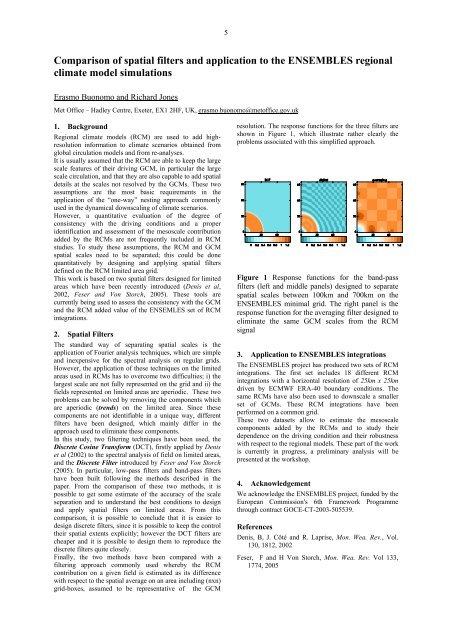Low (web) Quality - BALTEX
Low (web) Quality - BALTEX
Low (web) Quality - BALTEX
You also want an ePaper? Increase the reach of your titles
YUMPU automatically turns print PDFs into web optimized ePapers that Google loves.
5<br />
Comparison of spatial filters and application to the ENSEMBLES regional<br />
climate model simulations<br />
Erasmo Buonomo and Richard Jones<br />
Met Office – Hadley Centre, Exeter, EX1 2HF, UK, erasmo.buonomo@metoffice.gov.uk<br />
1. Background<br />
Regional climate models (RCM) are used to add highresolution<br />
information to climate scenarios obtained from<br />
global circulation models and from re-analyses.<br />
It is usually assumed that the RCM are able to keep the large<br />
scale features of their driving GCM, in particular the large<br />
scale circulation, and that they are also capable to add spatial<br />
details at the scales not resolved by the GCMs. These two<br />
assumptions are the most basic requirements in the<br />
application of the “one-way” nesting approach commonly<br />
used in the dynamical downscaling of climate scenarios.<br />
However, a quantitative evaluation of the degree of<br />
consistency with the driving conditions and a proper<br />
identification and assessment of the mesoscale contribution<br />
added by the RCMs are not frequently included in RCM<br />
studies. To study these assumptions, the RCM and GCM<br />
spatial scales need to be separated; this could be done<br />
quantitatively by designing and applying spatial filters<br />
defined on the RCM limited area grid.<br />
This work is based on two spatial filters designed for limited<br />
areas which have been recently introduced (Denis et al,<br />
2002, Feser and Von Storch, 2005). These tools are<br />
currently being used to assess the consistency with the GCM<br />
and the RCM added value of the ENSEMLES set of RCM<br />
integrations.<br />
2. Spatial Filters<br />
The standard way of separating spatial scales is the<br />
application of Fourier analysis techniques, which are simple<br />
and inexpensive for the spectral analysis on regular grids.<br />
However, the application of these techniques on the limited<br />
areas used in RCMs has to overcome two difficulties; i) the<br />
largest scale are not fully represented on the grid and ii) the<br />
fields represented on limited areas are aperiodic. These two<br />
problems can be solved by removing the components which<br />
are aperiodic (trends) on the limited area. Since these<br />
components are not identifiable in a unique way, different<br />
filters have been designed, which mainly differ in the<br />
approach used to eliminate these components.<br />
In this study, two filtering techniques have been used, the<br />
Discrete Cosine Transform (DCT), firstly applied by Denis<br />
et al (2002) to the spectral analysis of field on limited areas,<br />
and the Discrete Filter introduced by Feser and Von Storch<br />
(2005). In particular, low-pass filters and band-pass filters<br />
have been built following the methods described in the<br />
paper. From the comparison of these two methods, it is<br />
possible to get some estimate of the accuracy of the scale<br />
separation and to understand the best conditions to design<br />
and apply spatial filters on limited areas. From this<br />
comparison, it is possible to conclude that it is easier to<br />
design discrete filters, since it is possible to keep the control<br />
their spatial extents explicitly; however the DCT filters are<br />
cheaper and it is possible to design them to reproduce the<br />
discrete filters quite closely.<br />
Finally, the two methods have been compared with a<br />
filtering approach commonly used whereby the RCM<br />
contribution on a given field is estimated as its difference<br />
with respect to the spatial average on an area including (nxn)<br />
grid-boxes, assumed to be representative of the GCM<br />
resolution. The response functions for the three filters are<br />
shown in Figure 1, which illustrate rather clearly the<br />
problems associated with this simplified approach.<br />
Figure 1 Response functions for the band-pass<br />
filters (left and middle panels) designed to separate<br />
spatial scales between 100km and 700km on the<br />
ENSEMBLES minimal grid. The right panel is the<br />
response function for the averaging filter designed to<br />
eliminate the same GCM scales from the RCM<br />
signal<br />
3. Application to ENSEMBLES integrations<br />
The ENSEMBLES project has produced two sets of RCM<br />
integrations. The first set includes 18 different RCM<br />
integrations with a horizontal resolution of 25km x 25km<br />
driven by ECMWF ERA-40 boundary conditions. The<br />
same RCMs have also been used to downscale a smaller<br />
set of GCMs. These RCM integrations have been<br />
performed on a common grid.<br />
These two datasets allow to estimate the mesoscale<br />
components added by the RCMs and to study their<br />
dependence on the driving condition and their robustness<br />
with respect to the regional models. These part of the work<br />
is currently in progress, a preliminary analysis will be<br />
presented at the workshop.<br />
4. Acknowledgement<br />
We acknowledge the ENSEMBLES project, funded by the<br />
European Commission's 6th Framework Programme<br />
through contract GOCE-CT-2003-505539.<br />
References<br />
Denis, B, J. Côté and R. Laprise, Mon. Wea. Rev., Vol.<br />
130, 1812, 2002<br />
Feser, F and H Von Storch, Mon. Wea. Rev. Vol 133,<br />
1774, 2005













